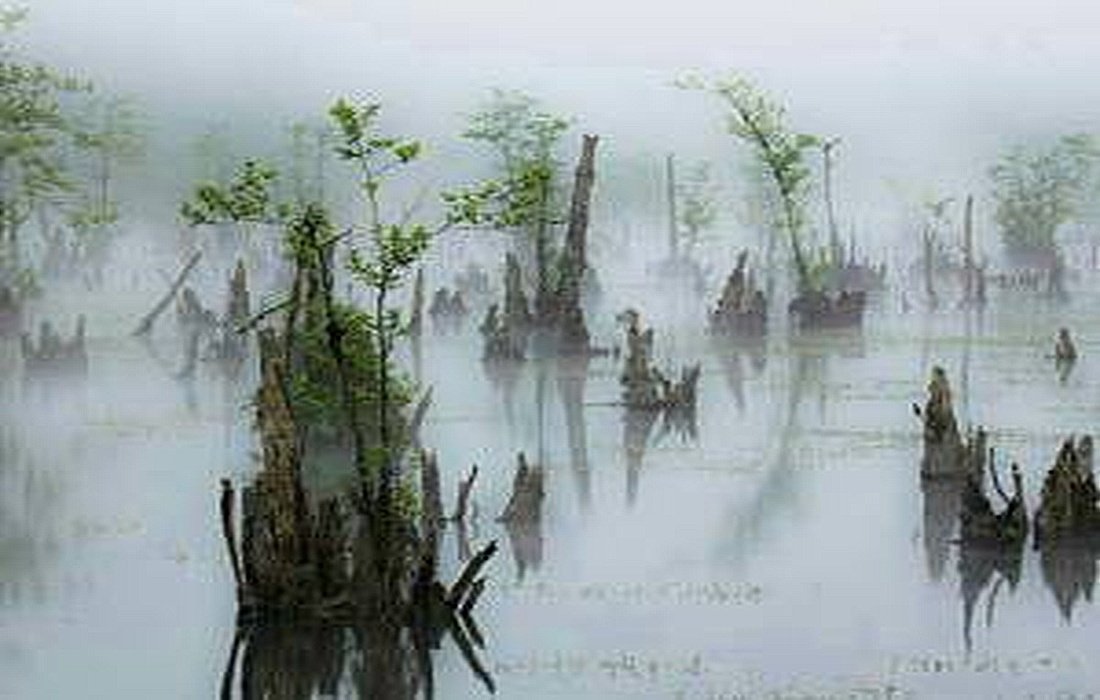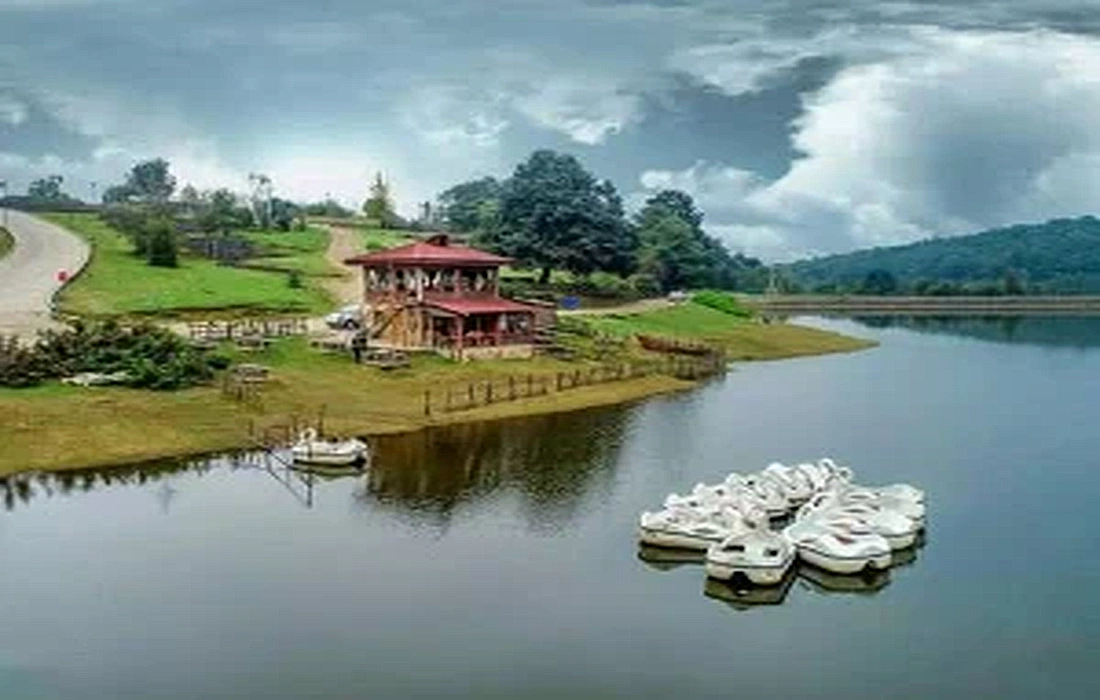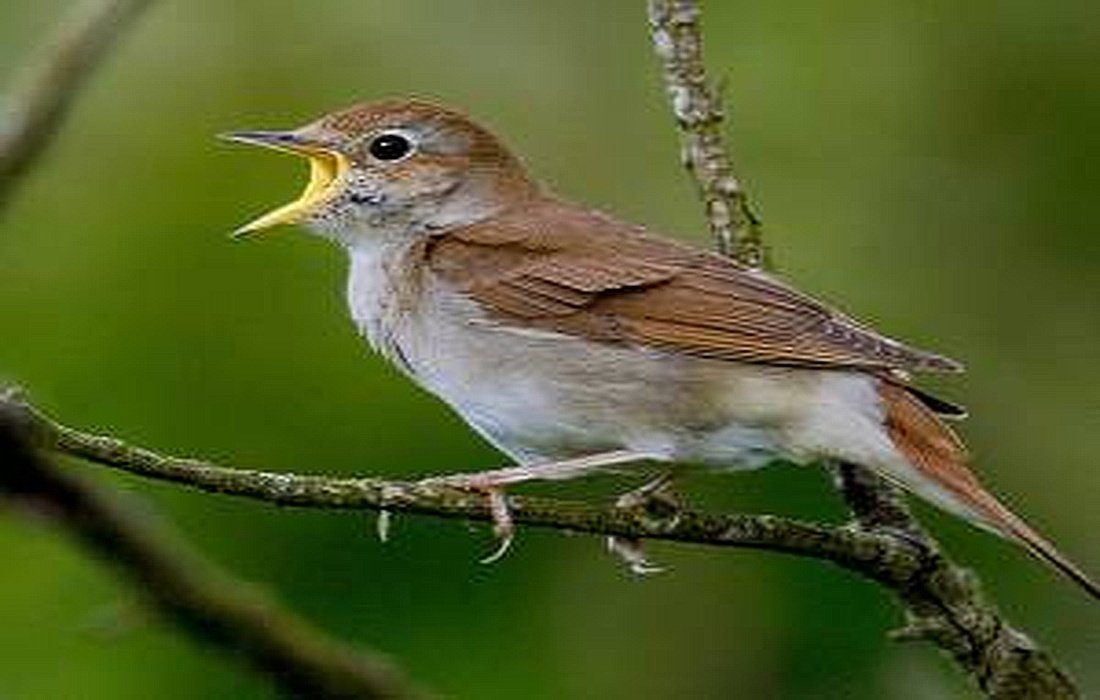Scary and mysterious places in Iran.
For a thrilling experience, you don’t always need to watch horror movies; sometimes visiting eerie and frightening places can be just as scary and exciting. In Iran, there are locations that are as haunting and breathtaking as those seen in Hollywood films.
Many of the scary and mysterious places in Iran have strange and sometimes unbelievable stories that pique the curiosity of foreign travelers, encouraging them to visit these areas.
In this section of tourism.SelMagz.We invite you to explore fascinating tourist destinations like the eerie atmosphere of old cemeteries, abandoned castles, and cottages that overflow with tales and legends.
The Jinni Castle.
In Kish Island, near the Greek Ship, there’s a small, abandoned castle that very few people visit as they hurry to see the Greek Ship, one of Kish’s most famous attractions. This castle is known as the Jinni Castle among the locals.
If you plan to visit it at night, no one will help you, as locals believe that jinn live in this castle. When darkness falls, the castle becomes an eerie place, and the sounds from a nearby well and the wind amplify its creepiness.
The Killer Cave.
Many of us picture a cave as a hole in the mountains, adorned with beautiful stalactites and perhaps some bats. However, there are many unique caves that are different and sometimes even deadly for climbers.
The presence of deep recesses, dark silence, and occasionally the sounds of creatures like bats in narrow corridors have always made such places thrilling for horror genre enthusiasts.
The Parav Cave, located 12 kilometers northeast of Kermanshah, near Chalabeh village, stands at an altitude of 3050 meters with a depth of 751 meters and 26 wells, making it one of the deepest and most inaccessible caves in the world. The deepest well in Parav reaches 42 meters; the cave entrance is completely sinkhole-like, making it unsuitable for ordinary tourists and even non-professional cave explorers.
The cold temperature inside the cave is due to flowing water from melting underground glaciers, always ranging between one and three degrees Celsius, making cave navigation challenging.
Furthermore, the presence of narrow passages and caves, some parts being prone to collapse, dangerous traverses, and deep wells have made Parav a difficult, mysterious cave world where five Iranian cavers have lost their lives, and some of their bodies have never been recovered.
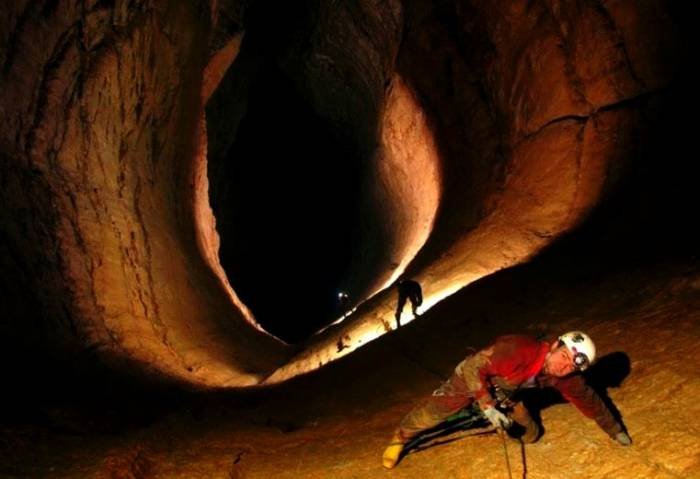
The Ghost Wetland.
The Ghost Wetland, named for its ancient past, is a lake located 12 kilometers from Nowshahr, 5 kilometers north of the Chalander village in the Mazandaran province.Mazandaran.It is situated among a dense broadleaf forest in the Malakla region. The lake is about 700 meters long and 300 meters wide.
There are dried trees within the lake that create an interesting sight. The combination of dead trees in the middle of the lake, the fog that often covers the lake, and the sounds of wild animals evoke thoughts of imaginative and horror films, giving this lake the title “Ghost Wetland.”
In the tourism section of SelMagz, we mentioned earlier that the Ghost Wetland is considered one of the most exciting tourist destinations in Mazandaran; if you’re keen to see scary and thrilling locations, we recommend visiting the Ghost Wetland.
The Stars Valley.
Qeshm Island possesses amazing and enchanting nature. A beautiful and mystical valley known as the Stars Valley is now recognized as one of the most beautiful attractions in Qeshm.
Besides its indescribable nature, it holds fascinating tales and legends. The local people of Qeshm believe that the magical shapes found in this valley were formed millions of years ago due to a star’s impact on Earth or by extraterrestrial beings.
With the wind blowing and the sandstorm’s arrival, a terrifying sound echoes from the intricate corridors of this valley, nestled between towering walls, resonating through the desert’s silence.
Local residents avoid this area during nightfall and urge travelers not to go there when it gets dark, as they believe spirits, jinn, and extraterrestrial entities roam the valley at night.
Just watching the strange and unusual shapes, formed by thousands of years of erosion in each sea rock, will leave you completely surprised and amazed.

The Bermuda Triangle of Iran.
The “Rig Jan” or “Bermuda Triangle of Iran” is one of the most inaccessible areas in the world, a desert region filled with sand dunes and salt marshes, considered one of Iran’s wonders and bringing death to any living creature due to its fierce marshes.
In this desert area, as far as the eye can see, there are sand dunes and salt marshes. Numerous unexplained events have occurred in this region, and its salt fields have become the site of many creatures’ deaths and burials.
This desert spans approximately 3800 square kilometers,located in the southwest and west of the Kavir plain, south of Semnan, southeast of Garmsar, east of Kavir National Park, north of Anarak (Isfahan), and west of Jandagh.No springs or water wells can be found in this region. The absence of water sources, combined with the salt marshes and extensive high sand dunes, has kept humans away from this area for centuries.
This desert is devoid of any plant or animal life, and no reports of life have ever been published. The extensive sand flats and marshes here instill terror in anyone who ventures into them. Traveling without equipment in this area could lead to a fate similar to that of the many missing persons in this place.
In the old days, people believed that this area was cursed and a dwelling place for evil spirits and the devil; if anyone stepped into this place, they would disappear, sent to the heart of “Rig Jan” by spirits and supernatural beings!
Even camels, according to one explorer, stop and won’t move upon reaching this area. Although the curse of the Bermuda Triangle of Iran was broken ten years ago by Ali Parsa, this adventurous Iranian finally succeeded in crossing this terrifying desert after several unsuccessful attempts.
The Ganj Soleiman Lake.
A beautiful, mysterious, and dangerous lake is known as the “Throne of Solomon,” located in Takab, West Azerbaijan Province. A tall mountain known as the Throne of Bilqis is situated in its northeastern part. The locals believe that the lake was created when Solomon’s staff struck the ground, hiding a valuable and ancient treasure at its depths.
Many brave and adventurous individuals have been drawn to the lake in search of this treasure, but the lake has swallowed them all, returning none of their bodies to shore. Numerous legends and stories surround this lake; some believe it to be the birthplace of Zoroaster, the prophet.
According to another historical legend, after Cyrus the Great’s victory over Croesus, the king of Lydia, who possessed legendary wealth, he threw all of his treasury and valuable items into this lake as a vow. Since then, the residents of this area have always dedicated their war spoils and valuable possessions to this lake. Although the Throne of Solomon Lake is very mysterious and dangerous, this aspect has become a vital attraction for both domestic and international tourists.
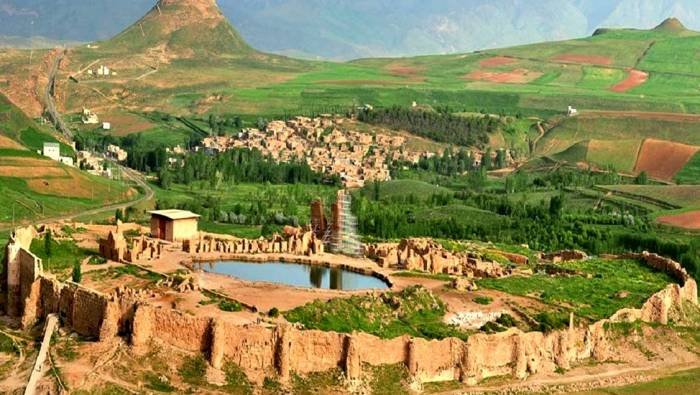
The Screaming Forest.
Near Mashhad, at the beginning of the Sarbarij village within the Torqabeh district, there exists a dense forest where terrifying sounds echo among its trees as darkness falls, described by locals and visitors to the area as resembling screams.
Some residents attribute these terrifying noises to locust swarms attacking the trees, while others believe unknown factors like weather contribute to the emergence of these sounds. Notably, these sounds have occurred for just a few years, with no prior record of their existence.
Since 2011, the very year these sounds began to resonate from the forest, water has continued to flow there, creating a captivating yet frightening phenomenon that stirs curiosity in tourists and makes camping a good option for those looking to experience fear and adrenaline.
The Stone Garden.
Sirjan is a city in southwestern Kerman known for many attractions, but among them exists a mysterious garden devoid of greenery. Instead of fruits, stone adorn its trees. The surrounding desert adds a sense of dread to this garden, enhancing its strangeness.
This Stone Garden, known as Darvish Khan Garden, was created by a farmer named “Darvish Khan Esfandiar Pour,” who around 40 years ago lost his farm to drought. As a form of protest, he moved his dead trees elsewhere, hanging stones he collected from the surrounding mountains as fruit from the trees.
Some believe that Darvish Khan dreamt of building this garden one night. The next day, while grazing sheep in the desert, he witnessed a meteor fall from the sky, took it home, and created his garden with it.
Darvish Khan was not satisfied with just hanging stones; he also hung the heads of sheep torn apart by wolves on the trees, but after public outcry, he stopped this practice. Exhaust pipes, worn-out gears, patched tires, oil cans, tin cans, broken mirrors, floating coolers, broken hookah tubes, and many other scraps have since adorned those trees.
After Darvish Khan’s death, locals have prevented one of the trees from falling. The only question that remains is how this old man managed to move these stones and hang them from the trees?
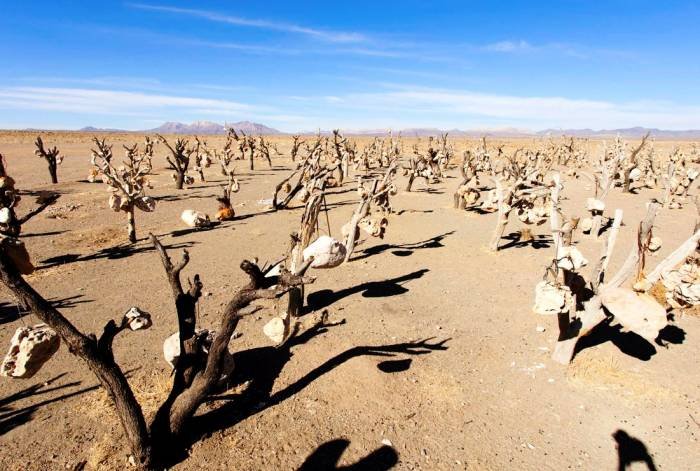
The Cemetery of Jinn.
In the southeasternmost corner of Iran, there’s a cemetery with huge gravestones that has become a fascinating place for adventurers interested in the supernatural. The Jinn Cemetery is located in the village of Tis near Chabahar city in Sistan and Baluchestan province, where locals believe these graves are not for humans and refer to it as the home of Jinn.
In the Jinn Cemetery, graves are excavated side by side on rocky surfaces, and this mode of burial raises numerous questions, ultimately leading to the world of the supernatural.
Locals believe that during the night, strange sounds can be heard in this village and that as darkness falls, Jinn weep over their dead. Anyone whose path crosses this cemetery at night is believed to be cursed, suffering severe agony and ultimately meeting their end within days.
Cemeteries are always eerie places and frequently have a prominent spot in horror films. The extremely large and unnatural size and the strange shapes on the stones lead people to believe that Jinn are buried beneath them.
According to folklore, no human has been seen wielding a pickaxe to chisel stone in order to bury a corpse. Others believe that perhaps the diggers endured the labor of cutting rock to protect the deceased from beasts and underground predators, constructing such graves to honor their lost ones.
Hell Valley.
There is a region called “Hell Valley” in a mountainous area of Khoy city in West Azerbaijan. The valley’s reputation is so widespread among locals that no one dares to visit it for any leisurely activity. The towering mountains in the region make it very treacherous, contributing to its sinister name.
Hell Valley is regarded as dangerous both physically and mentally for the local inhabitants. Those who volunteer to go there have never returned.
The Cannibal’s Castle.
The ancient Boohi Yoghoun Castle is located in the village of Kor Abbasloo in Ardabil province. This peculiar site, like many other human-made attractions, remains abandoned, hence it holds even more mystery for storytelling. According to locals, individuals who ventured to this ancient castle mysteriously disappeared, swallowed by the castle.
The Ruins Full of Tales.
Old ruins and castles are generally creepy and eerie, and these man-made sites are often steeped in mystery. One of these terrifying castles, known as the Old Zahridan Castle, is located 27 kilometers east of Zabol in Sistan and Baluchestan.
This castle is also listed as a UNESCO World Heritage site. Within its walls lie many scary stories and legends, claiming that spirits and jinn govern this castle.



